![]()
You may have heard some remarkable stories about Pakistan as a tourism hub from your parents and grandparents. The 60s and 70s, in particular, were the decades when tourism in Pakistan saw its prime.
The pictures of those days can still be found doing rounds on the internet, boasting a plethora of visitors from all around.
Those were the days when Pakistan would invariably feature in the lists of international tourist destinations. I haven’t seen that Pakistan, but I can well imagine it, owing to the accounts I’ve had from many people around. Therefore, when I came across this article titled, ‘Pakistan tourism: a sleeping giant?’ in an Australian magazine, shedding light on the aspects of Pakistan as a treat for tourists, I couldn’t help add my own two cents to the topic.
The article starts off with an oft-repeated, almost clichéd line:
“It’s a part of the world that usually makes headlines for all the wrong reasons…”
Then the article goes on to indulge in the possibilities that can be drawn from
Pakistan’s tourism, narrating its beauty and destinations, and no one can disagree.
In 2009, the World Economic Forum’s travel and tourism competitiveness report ranked Pakistan as one of the top 25 per cent tourist destinations for its world heritage sites. Pakistan’s rich heritage is one that outdoes many countries of the world.
The United Nations Educational, Scientific and Cultural Organization (UNESCO) has enlisted six Pakistani sites as 'world heritage sites'. These include the magnificent Shalimar Gardens. the fort in Lahore, the Makli monuments in Sindh, the ruins of Moenjodaro also in Sindh, Rohtas Fort near Jhelum, Buddhist ruins in Takht-i-Bahi and the ancient city of Taxila. 18 other sites, including the Baltit fort in Hunza and the tomb of Shah Rukne Alam in Multan, have been classified as 'tentative sites' by the same.
![]() (The Makli graveyard in Thatta famous for its architecture. PHOTO: FILE)
(The Makli graveyard in Thatta famous for its architecture. PHOTO: FILE)
![]() (The Shalimar Garden in Lahore. PHOTO: CPS/FILE)
(The Shalimar Garden in Lahore. PHOTO: CPS/FILE)
Monuments and structures, dating back to 3300 BC can be found, and impressions from varied dynasties and time periods hold testimony to the rich historical back-drop of Pakistan.
It’s not just heritage.
Geographically, the country is as rich as it gets. From the snow-capped mountains of the north to the deserts of Thar; from the plains of Punjab to the plateau of Potohar; from the Salt range to the coast of Makran; the country comes solid on the scale of geographical diversity. Lush green fields, healthy hill stations, azure skies and clear rivers - you get all here.
![]() (The rocky mountains of Zhob, Balochistan. PHOTO: M ASIF NAWAZ)
Then there’s the culture
(The rocky mountains of Zhob, Balochistan. PHOTO: M ASIF NAWAZ)
Then there’s the culture - the sumptuous cuisines, the multitude of languages, the flamboyant attire, the soulful music, and the genial demeanour.
![]() (Intricate art on public buses and trucks is now a part of Pakistani culture. PHOTO: AFP)
(Intricate art on public buses and trucks is now a part of Pakistani culture. PHOTO: AFP)
We have cities brimming with all the progression of modern life, and villages where ‘
saag’ and ‘
makai ki roti’ are still devoured beneath
peepal trees with stocky glasses of
lassi! All this ascertains the great potential that Pakistan has as a grand tourist destination.
![]() (Peanuts roasted in sand are a specialty in Pakistan and are sold on the street. PHOTO: ONLINE)
(Peanuts roasted in sand are a specialty in Pakistan and are sold on the street. PHOTO: ONLINE)
![]() (Devotees performing 'dhamaal' to the sounds of dhol is a special sight for tourists. PHOTO: REUTERS)
(Devotees performing 'dhamaal' to the sounds of dhol is a special sight for tourists. PHOTO: REUTERS)
But then, as this article points out, the problem here lies in the world ‘potential’.
Despite the excess of offerings that Pakistan can make to its tourists, ‘Pakistan has fallen behind neighbouring India, Nepal, Sri Lanka, Maldives and Bhutan’ when it comes to tourism, and that’s where the bad news begins.
Given the political instability of the country, which can be dated back to about forever, it comes off as no surprise that many international travel agencies warn their clients not to visit Pakistan. Let international tourism be; even domestic tourism has been affected unfavourably by the waves of terrorism and lack of law and order in the country.
Moreover, natural calamities such as the 2005 earthquake and
2009 floods have also added to the chagrin. Despite this, the
Discovery Channel’s Insight Guides series on Pakistan begs to differ, and rather states that in spite of its dubious disposition, statistics shows that Pakistan remains an excessively safe country for tourism!
Accordingly, tourists will tour. It may be argued that it’s actually the tourism industry of Pakistan that’s keeping the tourists at bay. True, there are some places in the country that must not be recommended to travel to, but it’s due to a lack of will on part of the government that the tourism industry is on life-support even in the safer places.
Here’s a quote from the same article,
“According to an analyst at the Sustainable Development Policy Institute in Islamabad, Pakistan’s tourism sector has failed to grow due to continued mismanagement of the industry. There’s nothing new there.”
No surprises there. Accordingly, the same World Economic Forum that was all praise for our heritage in 2009, has ranked
Pakistan at 122 out of 140 countries in its latest travel and tourism competitiveness report. A sorry state of policy rules and regulations has been cited by the report as the most probable hindrances to a blooming tourism industry in the country, followed by poor prioritising of travel and tourism. Ethiopia, Uganda, Ghana, and Zimbabwe, all have fared better than Pakistan. (Just as a consolation though, that’s three places better than where we were last year!)
It is not far from the truth though. The poor state of leisure tourism in Pakistan emanates basically from the sheer absence of any tourism facilities. A single look on the Pakistan government’s tourism website can give you a pretty clear idea of that.
Advertisements and propagation of
Pakistan as a tourist destination in international media is another sorry tale. The basic services to those who visit the country are at a bare minimum. Moreover, many of the tourist spots are consistently facing gross negligence and nobody seems to be bothered.
Tourism, like every industry, needs its due investment before it’s profitable. While there’s no input, sadly, it’s only just that tourism is neither alive nor kicking in the country.
But then, on a positive and honest note, there’s one entity in Pakistan that pretty much makes up (or at least tries to) for all these fallacies, and it’s the people of the country! Nothing, perhaps, sums it up more comprehensively than what
Lonely Planet has to say about Pakistan:
“Although conservative, Pakistanis are by nature a welcoming and hospitable people to foreigners, trying to get by in the face of indifference from their government and occasional hostility from the outside world… The scams and hustle you might experience in heavily travelled India are nowhere to be seen here. Instead, look forward to spontaneously offered cups of tea and conversations about cricket. You will feel like you have the country to yourself. Attractions that would have been splashed over the glossy pages of newspaper travel supplements are almost empty. While enthusiastic travel advice comes tinged with official government travel advisories, you’ll need to keep one eye on the news before booking your ticket – but once here, you’ll realise that Pakistan really is one of the world’s best-kept travel secrets.”
Therefore, the next time you’re on a break from work and wish to see all things beautiful and exciting, pack your bags and come to Pakistan. It might not be a bed of roses, but you won’t be disappointed.
And that’s the promise of Pakistan!
Read more by Asif here or follow him on Twitter @asifnz



 (The Makli graveyard in Thatta famous for its architecture. PHOTO: FILE)
(The Makli graveyard in Thatta famous for its architecture. PHOTO: FILE)
 (The Shalimar Garden in Lahore. PHOTO: CPS/FILE)
Monuments and structures, dating back to 3300 BC can be found, and impressions from varied dynasties and time periods hold testimony to the rich historical back-drop of Pakistan.
It’s not just heritage.
Geographically, the country is as rich as it gets. From the snow-capped mountains of the north to the deserts of Thar; from the plains of Punjab to the plateau of Potohar; from the Salt range to the coast of Makran; the country comes solid on the scale of geographical diversity. Lush green fields, healthy hill stations, azure skies and clear rivers - you get all here.
(The Shalimar Garden in Lahore. PHOTO: CPS/FILE)
Monuments and structures, dating back to 3300 BC can be found, and impressions from varied dynasties and time periods hold testimony to the rich historical back-drop of Pakistan.
It’s not just heritage.
Geographically, the country is as rich as it gets. From the snow-capped mountains of the north to the deserts of Thar; from the plains of Punjab to the plateau of Potohar; from the Salt range to the coast of Makran; the country comes solid on the scale of geographical diversity. Lush green fields, healthy hill stations, azure skies and clear rivers - you get all here.
 (The rocky mountains of Zhob, Balochistan. PHOTO: M ASIF NAWAZ)
(The rocky mountains of Zhob, Balochistan. PHOTO: M ASIF NAWAZ)
 (Intricate art on public buses and trucks is now a part of Pakistani culture. PHOTO: AFP)
We have cities brimming with all the progression of modern life, and villages where ‘saag’ and ‘makai ki roti’ are still devoured beneath peepal trees with stocky glasses of lassi! All this ascertains the great potential that Pakistan has as a grand tourist destination.
(Intricate art on public buses and trucks is now a part of Pakistani culture. PHOTO: AFP)
We have cities brimming with all the progression of modern life, and villages where ‘saag’ and ‘makai ki roti’ are still devoured beneath peepal trees with stocky glasses of lassi! All this ascertains the great potential that Pakistan has as a grand tourist destination.
 (Peanuts roasted in sand are a specialty in Pakistan and are sold on the street. PHOTO: ONLINE)
(Peanuts roasted in sand are a specialty in Pakistan and are sold on the street. PHOTO: ONLINE)
 (Devotees performing 'dhamaal' to the sounds of dhol is a special sight for tourists. PHOTO: REUTERS)
But then, as this article points out, the problem here lies in the world ‘potential’.
Despite the excess of offerings that Pakistan can make to its tourists, ‘Pakistan has fallen behind neighbouring India, Nepal, Sri Lanka, Maldives and Bhutan’ when it comes to tourism, and that’s where the bad news begins.
Given the political instability of the country, which can be dated back to about forever, it comes off as no surprise that many international travel agencies warn their clients not to visit Pakistan. Let international tourism be; even domestic tourism has been affected unfavourably by the waves of terrorism and lack of law and order in the country.
Moreover, natural calamities such as the 2005 earthquake and
(Devotees performing 'dhamaal' to the sounds of dhol is a special sight for tourists. PHOTO: REUTERS)
But then, as this article points out, the problem here lies in the world ‘potential’.
Despite the excess of offerings that Pakistan can make to its tourists, ‘Pakistan has fallen behind neighbouring India, Nepal, Sri Lanka, Maldives and Bhutan’ when it comes to tourism, and that’s where the bad news begins.
Given the political instability of the country, which can be dated back to about forever, it comes off as no surprise that many international travel agencies warn their clients not to visit Pakistan. Let international tourism be; even domestic tourism has been affected unfavourably by the waves of terrorism and lack of law and order in the country.
Moreover, natural calamities such as the 2005 earthquake and 
 Photo: Reuters
Pushing, punching, kicking, shouting, angry faces, sweaty bodies, flying bags, crying babies - by the end, your'e bruised, battered, exhausted, but you are on the train. Getting off the train is equally frustrating - people rushing in don’t give you a chance to get out, another round of getting beaten up and you are out!
It’s better to take a taxi, but roads are usually choked and it takes an endless number of hours to reach home (plus the taxi meter keeps piling up.)
The Chinese
Photo: Reuters
Pushing, punching, kicking, shouting, angry faces, sweaty bodies, flying bags, crying babies - by the end, your'e bruised, battered, exhausted, but you are on the train. Getting off the train is equally frustrating - people rushing in don’t give you a chance to get out, another round of getting beaten up and you are out!
It’s better to take a taxi, but roads are usually choked and it takes an endless number of hours to reach home (plus the taxi meter keeps piling up.)
The Chinese  Photo: Zain Raza
Eating lunch with my colleagues at work is quite interesting; they eat pork chops and rice cooked in pork broth while I devour my fish, squid, shrimp, and vegetables. Mind you, I have mastered the art of eating with chopsticks - even rice; it took a while but I am a pro now!
Photo: Zain Raza
Eating lunch with my colleagues at work is quite interesting; they eat pork chops and rice cooked in pork broth while I devour my fish, squid, shrimp, and vegetables. Mind you, I have mastered the art of eating with chopsticks - even rice; it took a while but I am a pro now!
 Photo: Zain Raza
They often ask why I don’t eat pork, but when I attempt to answer, they don’t really comprehend. It is difficult trying to explain why I can’t eat pork, they don’t have the kind of exposure to Islam that Europeans or Americans do. Some are even curious to know what makes
Photo: Zain Raza
They often ask why I don’t eat pork, but when I attempt to answer, they don’t really comprehend. It is difficult trying to explain why I can’t eat pork, they don’t have the kind of exposure to Islam that Europeans or Americans do. Some are even curious to know what makes 
 Photo: Jalal Awan
As we pondered over Google maps for the nearest Halal food joint at the airport, we were approached by courteous passers-by volunteering assistance and even offering free rides to the taxi stand.
The vast majority of travellers confine their island time to a select few of a core of around 10 to 15 main islands dotted on the fringes of the Andaman Sea, leaving the other 500-or-so for next time, presumably.
Primary pullers of the backpacker crowd at Thailand are undoubtedly the islands on either side of the country’s southern-most stretch, Koh Samui, Koh Phangan and Koh Tao to name a few.
Koh Phangan’s account is incomplete without the mention of the world (in) famous full-moon party, a debauched booze-fest of music and dance combining tens of thousands of young backpackers, and bootleggers, from all over the world.
Photo: Jalal Awan
As we pondered over Google maps for the nearest Halal food joint at the airport, we were approached by courteous passers-by volunteering assistance and even offering free rides to the taxi stand.
The vast majority of travellers confine their island time to a select few of a core of around 10 to 15 main islands dotted on the fringes of the Andaman Sea, leaving the other 500-or-so for next time, presumably.
Primary pullers of the backpacker crowd at Thailand are undoubtedly the islands on either side of the country’s southern-most stretch, Koh Samui, Koh Phangan and Koh Tao to name a few.
Koh Phangan’s account is incomplete without the mention of the world (in) famous full-moon party, a debauched booze-fest of music and dance combining tens of thousands of young backpackers, and bootleggers, from all over the world.
 Photo: Jalal Awan
Up North, Phuket is one of the gems of the Thai tourism industry, with some of the best islands and sophisticated resort developments. But a visit to Patong and the infamous Bangla Road, you realise that it’s not just the sun and sand after all.
There’s another, albeit risqué, aspect to Phuket: nightlife- the lesser said the better!
Scuba-diving, snorkelling, parasailing, rafting and safari rides are must-dos while staying at Phuket. Scuba-diving in particular is an awe-inspiring experience- the impressions from undersea adventures completely exceeded our expectations.
It’s an amazing excursion to a whole new breath-taking world!
Photo: Jalal Awan
Up North, Phuket is one of the gems of the Thai tourism industry, with some of the best islands and sophisticated resort developments. But a visit to Patong and the infamous Bangla Road, you realise that it’s not just the sun and sand after all.
There’s another, albeit risqué, aspect to Phuket: nightlife- the lesser said the better!
Scuba-diving, snorkelling, parasailing, rafting and safari rides are must-dos while staying at Phuket. Scuba-diving in particular is an awe-inspiring experience- the impressions from undersea adventures completely exceeded our expectations.
It’s an amazing excursion to a whole new breath-taking world!
 Photo: Jalal Awan
As we travelled by land, air and sea to our final abode in Bangkok’s Siam area, we met jet-setters and adventure virtuosos from (almost) all over the world.
We found people associating Pakistanis with almost everything from Nusrat Fateh Ali Khan’s singing talent to Bin Laden’s soon-to-
Photo: Jalal Awan
As we travelled by land, air and sea to our final abode in Bangkok’s Siam area, we met jet-setters and adventure virtuosos from (almost) all over the world.
We found people associating Pakistanis with almost everything from Nusrat Fateh Ali Khan’s singing talent to Bin Laden’s soon-to-
 [/caption]
My words will fall short in describing Korea. South Koreans are usually crazy about technology and workaholics. They’re people who, by any means, have pledged to take their country even far ahead from where it is now. South Korea is one happy nation!
[caption id="" align="alignnone" width="500" caption="Kyung Hee Observatory"]
[/caption]
My words will fall short in describing Korea. South Koreans are usually crazy about technology and workaholics. They’re people who, by any means, have pledged to take their country even far ahead from where it is now. South Korea is one happy nation!
[caption id="" align="alignnone" width="500" caption="Kyung Hee Observatory"] [/caption]
Everything was going just fine, until recently, when I started getting calls from home enquiring about the tensions in the Korean peninsula. Due to this sudden interest, I started following the news, and would watch or read it at least five times daily. Honestly, the media had me scared, especially after getting the memo from Pakistan embassy in Seoul, stating their close eye on the situation and mentioning the worst cases. What do they mean by 'worst cases'? Well let’s follow the news again.
What did I get in the news, you ask?
The media appeared to be bombarded with news like “Korea is having their
[/caption]
Everything was going just fine, until recently, when I started getting calls from home enquiring about the tensions in the Korean peninsula. Due to this sudden interest, I started following the news, and would watch or read it at least five times daily. Honestly, the media had me scared, especially after getting the memo from Pakistan embassy in Seoul, stating their close eye on the situation and mentioning the worst cases. What do they mean by 'worst cases'? Well let’s follow the news again.
What did I get in the news, you ask?
The media appeared to be bombarded with news like “Korea is having their  [/caption]
The strangest thing I noticed during this critical time was the reaction of South Koreans - so calm, so content, continuing with their daily activities as if nothing is happening. Hmm, seems like they have gotten used to all this 'exchange of rhetoric'. The news that I followed assured me of it.
These kinds of situations have come and gone many times before. The way people deal with them now is to hear them from one ear and throw them out the other; they keep on living in a world where everything is just fine.
[caption id="" align="alignnone" width="300" caption="63 Building Sunset"]
[/caption]
The strangest thing I noticed during this critical time was the reaction of South Koreans - so calm, so content, continuing with their daily activities as if nothing is happening. Hmm, seems like they have gotten used to all this 'exchange of rhetoric'. The news that I followed assured me of it.
These kinds of situations have come and gone many times before. The way people deal with them now is to hear them from one ear and throw them out the other; they keep on living in a world where everything is just fine.
[caption id="" align="alignnone" width="300" caption="63 Building Sunset"] [/caption]
There is a huge clash of lifestyle between
[/caption]
There is a huge clash of lifestyle between 
 [/caption]
All four of them were aiming to hoist the Pakistani and India flags together at the summit and spread the message of peace and friendship.
[caption id="" align="alignnone" width="356" caption="KARAKORAMEXPEDITION.COM"]
[/caption]
All four of them were aiming to hoist the Pakistani and India flags together at the summit and spread the message of peace and friendship.
[caption id="" align="alignnone" width="356" caption="KARAKORAMEXPEDITION.COM"] [/caption]
The expedition kicked off from April 1, 2013, and ended on 19 May, 2013, at 7:40am. Samina became the
[/caption]
The expedition kicked off from April 1, 2013, and ended on 19 May, 2013, at 7:40am. Samina became the  [/caption]
It’s a proud moment for Pakistan and India both, so let’s forget all the differences and unite to celebrate this historic moment. Let’s also hope and pray that this news will bring new life to the dying tourism industry of Pakistan.
Our country possesses plenty of potential tourist attractions, from fine examples of Mughal and Buddhist architecture to some of the world’s highest mountains. We have snow-peaked mountains and vast deserts where people live in a fascinating, rich culture. However, in recent years, convincing foreigners to come visit Pakistan has been an uphill battle. To tempt people from other countries to visit Pakistan would be more difficult today than to outline a workable peace plan between Palestine and Israel.
The government has to take special measures for providing relief to tourists if it wants to boost the
[/caption]
It’s a proud moment for Pakistan and India both, so let’s forget all the differences and unite to celebrate this historic moment. Let’s also hope and pray that this news will bring new life to the dying tourism industry of Pakistan.
Our country possesses plenty of potential tourist attractions, from fine examples of Mughal and Buddhist architecture to some of the world’s highest mountains. We have snow-peaked mountains and vast deserts where people live in a fascinating, rich culture. However, in recent years, convincing foreigners to come visit Pakistan has been an uphill battle. To tempt people from other countries to visit Pakistan would be more difficult today than to outline a workable peace plan between Palestine and Israel.
The government has to take special measures for providing relief to tourists if it wants to boost the 
 The Han river[/caption]
[caption id="" align="alignnone" width="480"]
The Han river[/caption]
[caption id="" align="alignnone" width="480"] Seoul Grand Park[/caption]
Later, my friends and I went to see the light show that happens every night around 8pm to 9pm. We visited one of the many bridges that divide the North of Seoul from the South of Seoul. This place is called Banpo Park and is frequented by couples, families, friends and those who enjoy a nice walk or love to ride bikes.
When I first came here, I was a bit afraid because I had read too many articles about Koreans being ‘racist’. However, this was not true. I stood shivering in the cold early in the morning of my second day in Seoul. A woman walked up to me and asked if I was American. I told her I was from Pakistan.
At this point I wasn’t sure how she would react to my country but she smiled and said,
Seoul Grand Park[/caption]
Later, my friends and I went to see the light show that happens every night around 8pm to 9pm. We visited one of the many bridges that divide the North of Seoul from the South of Seoul. This place is called Banpo Park and is frequented by couples, families, friends and those who enjoy a nice walk or love to ride bikes.
When I first came here, I was a bit afraid because I had read too many articles about Koreans being ‘racist’. However, this was not true. I stood shivering in the cold early in the morning of my second day in Seoul. A woman walked up to me and asked if I was American. I told her I was from Pakistan.
At this point I wasn’t sure how she would react to my country but she smiled and said,
 A famous South Korean cosmetic company[/caption]
Gangnam is an area in Seoul, on which the song
A famous South Korean cosmetic company[/caption]
Gangnam is an area in Seoul, on which the song  Apgujeong area[/caption]
Myeongdong is another place that is popular with Koreans and foreigners alike. It is full of cafés, shops and K-pop merchandise. It, too, is expensive and very crowded.
Korean food tends to be a bit on the spicy side, but if you are from Pakistan, nothing can take you by surprise. The spiciest food so far has been ‘ddeokboki’, which is rice cakes mixed in chilli sauce. It is delicious, especially if you’re shivering in the -13° C and having it from one of the food stands along the road with friends.
[caption id="" align="alignnone" width="480"]
Apgujeong area[/caption]
Myeongdong is another place that is popular with Koreans and foreigners alike. It is full of cafés, shops and K-pop merchandise. It, too, is expensive and very crowded.
Korean food tends to be a bit on the spicy side, but if you are from Pakistan, nothing can take you by surprise. The spiciest food so far has been ‘ddeokboki’, which is rice cakes mixed in chilli sauce. It is delicious, especially if you’re shivering in the -13° C and having it from one of the food stands along the road with friends.
[caption id="" align="alignnone" width="480"] Street food in Korea[/caption]
Koreans eat a lot of pork but there are always other options. ‘Bibimbap’ is one of my personal favourites. It’s usually a mix of vegetables and rice but sometimes has chicken, depending on what you order.
South Korea seems to be unheard of and I was mocked at when I told people that I plan to live here in the future as well because it is a common choice amongst people my age to prefer the West. However so far, so good; I have no regrets.
The East has been great to me. Aside from the
Street food in Korea[/caption]
Koreans eat a lot of pork but there are always other options. ‘Bibimbap’ is one of my personal favourites. It’s usually a mix of vegetables and rice but sometimes has chicken, depending on what you order.
South Korea seems to be unheard of and I was mocked at when I told people that I plan to live here in the future as well because it is a common choice amongst people my age to prefer the West. However so far, so good; I have no regrets.
The East has been great to me. Aside from the 
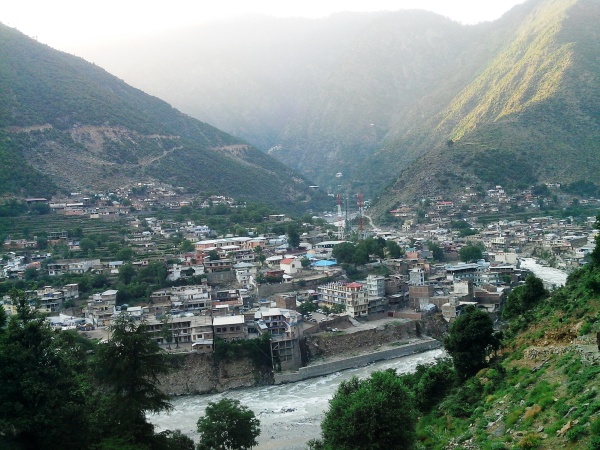 Since the last successful military offensive against the Swat Taliban the military in Swat arrange festivals in the valley. These events of entertainment are meant to
Since the last successful military offensive against the Swat Taliban the military in Swat arrange festivals in the valley. These events of entertainment are meant to 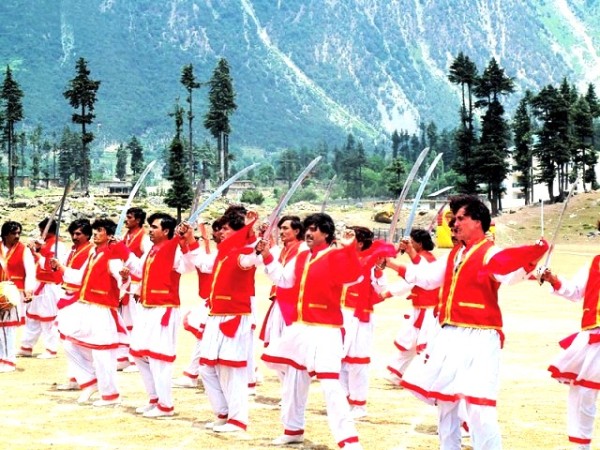 Whatever the motives are, one thing is crystal clear, that the festivals have effectively revived the
Whatever the motives are, one thing is crystal clear, that the festivals have effectively revived the  Swat Valley is among the cherished destinations of common tourists. Besides, it has many sites for mountaineers, trekkers, hikers, winter sportsmen and drifters which are still to be discovered and promoted.
Swat Valley is among the cherished destinations of common tourists. Besides, it has many sites for mountaineers, trekkers, hikers, winter sportsmen and drifters which are still to be discovered and promoted.
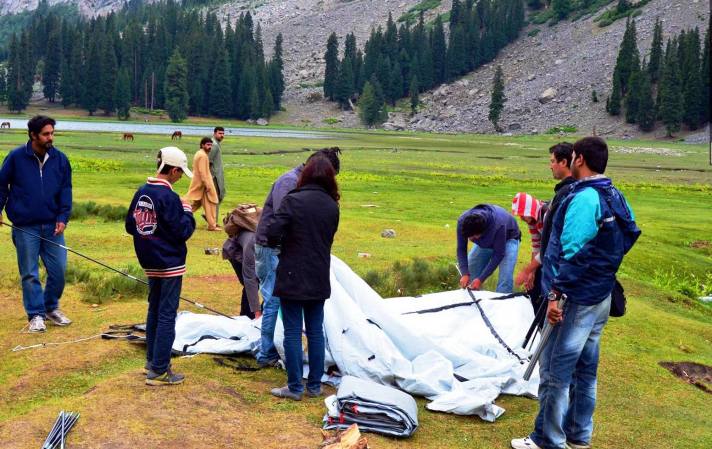 The Swat Summer Festival is annually held in Kalam and in Mahee Dhaan (Mahu Dand) — an enchanting valley and lake at an altitude of 10,500 feet from sea level — which can by now be accessed via every type of vehicle. It is 35 km from Kalam. It takes two hours to reach there by the bank of an emerald stream from the lakes and glaciers above the valley.
The Swat Summer Festival is annually held in Kalam and in Mahee Dhaan (Mahu Dand) — an enchanting valley and lake at an altitude of 10,500 feet from sea level — which can by now be accessed via every type of vehicle. It is 35 km from Kalam. It takes two hours to reach there by the bank of an emerald stream from the lakes and glaciers above the valley.
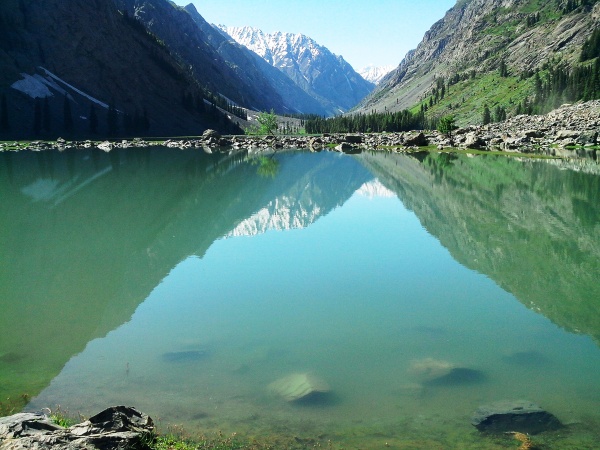 The festival in Kalam and in Mahee Dhaan commenced on June 19 and will continue for a full four days. There will be jeep racing, cliff climbing, paragliding, trekking and rowing in the lake. The festival in Kalam will have live concerts, songs, dances and stalls for families.
The festival in Kalam and in Mahee Dhaan commenced on June 19 and will continue for a full four days. There will be jeep racing, cliff climbing, paragliding, trekking and rowing in the lake. The festival in Kalam will have live concerts, songs, dances and stalls for families.
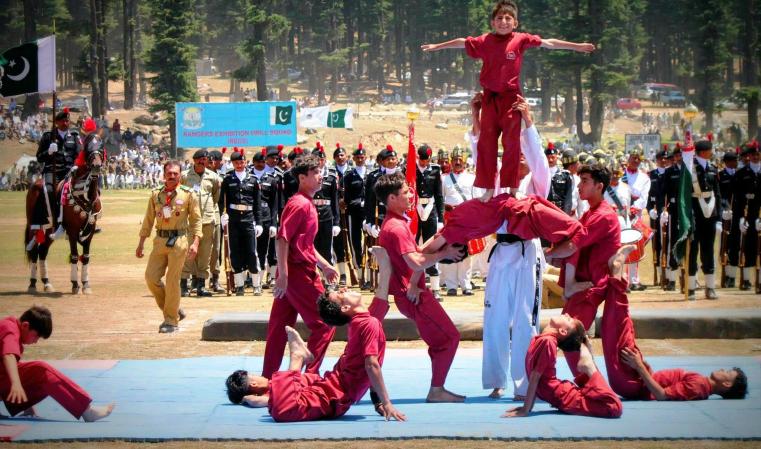 One distinct characteristic of the Swat Summer Festival this year are the shows of local — Torwali and Kalami (Gawri) — culture. The local but unique culture and the languages are endangered. Presentation of it in the festival is meant to educate the tourists on the unique non-Pashtun identity of the people of Bahrain hill station and Kalam. It is also meant promote the particular languages and culture and to take the local people on board.
One distinct characteristic of the Swat Summer Festival this year are the shows of local — Torwali and Kalami (Gawri) — culture. The local but unique culture and the languages are endangered. Presentation of it in the festival is meant to educate the tourists on the unique non-Pashtun identity of the people of Bahrain hill station and Kalam. It is also meant promote the particular languages and culture and to take the local people on board.
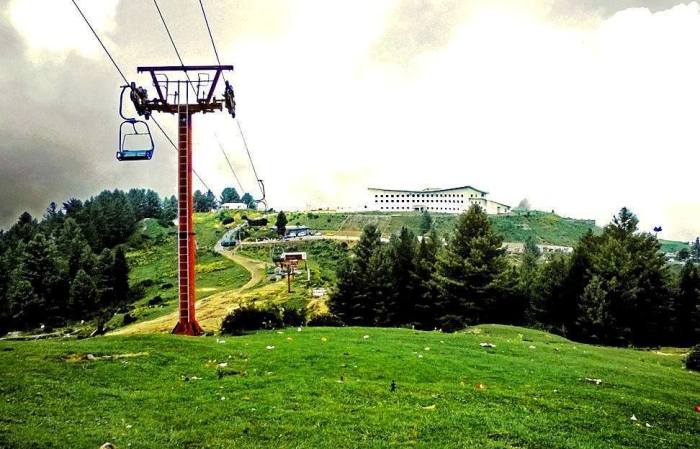 The local population, other than the shopkeepers and hoteliers, are not pleased with what was happening on their land in the name of such festivals, primarily because of the damage tourists do to the natural environment.
The local population, other than the shopkeepers and hoteliers, are not pleased with what was happening on their land in the name of such festivals, primarily because of the damage tourists do to the natural environment.
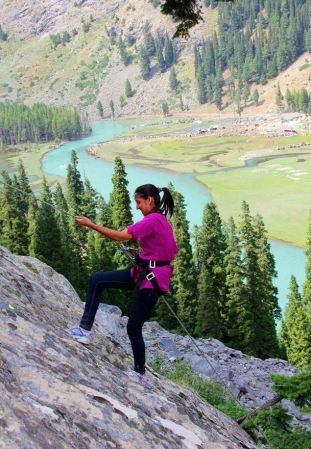 A number of the native civil society of Bahrain and Kalam expect care from the tourists whom the locals always called Melaesh (guests). Unfortunately, in Pakistan, the environment has never been a priority among the general public. Neither is it a priority in the governments.
A number of the native civil society of Bahrain and Kalam expect care from the tourists whom the locals always called Melaesh (guests). Unfortunately, in Pakistan, the environment has never been a priority among the general public. Neither is it a priority in the governments.
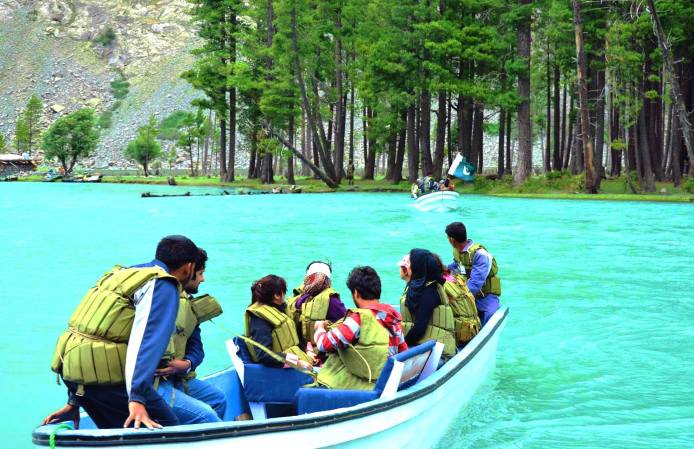 In Swat, unfortunately, rowing is not done with oars. This causes a lot of pollution in the water as petrol engines are used to run the boats on the lake. Canoes with oars would be great for the environment and a much-needed measure to maintain the beauty of the lake.
In Swat, unfortunately, rowing is not done with oars. This causes a lot of pollution in the water as petrol engines are used to run the boats on the lake. Canoes with oars would be great for the environment and a much-needed measure to maintain the beauty of the lake.
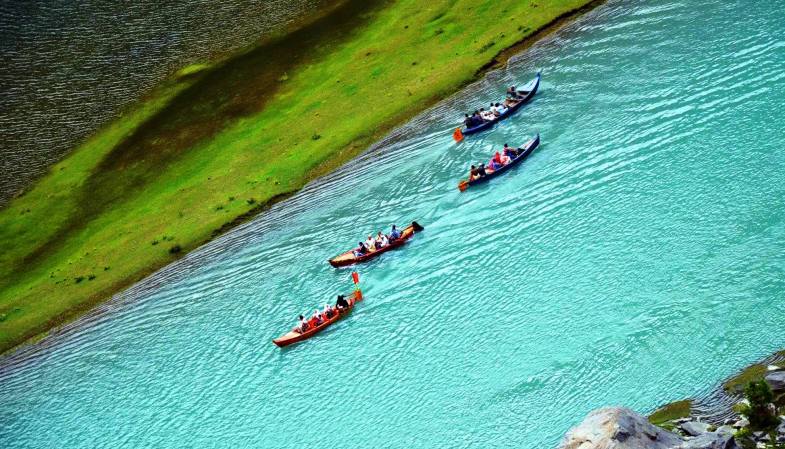 The lake area is the best place for short time camping, tents brought in by tourists help them stay among fairies for few days. There are short treks on the peaks; and paths for similar adventures. The sun rise here is worth capturing and the nights are no less gripping and fortunately, on the days of the festival, the night skies will be lit up with moonlight. One really can’t compare the feeling of being among the stars underneath a clear sky; it’s as if the angels from above send down fairies to greet you.
The lake area is the best place for short time camping, tents brought in by tourists help them stay among fairies for few days. There are short treks on the peaks; and paths for similar adventures. The sun rise here is worth capturing and the nights are no less gripping and fortunately, on the days of the festival, the night skies will be lit up with moonlight. One really can’t compare the feeling of being among the stars underneath a clear sky; it’s as if the angels from above send down fairies to greet you.
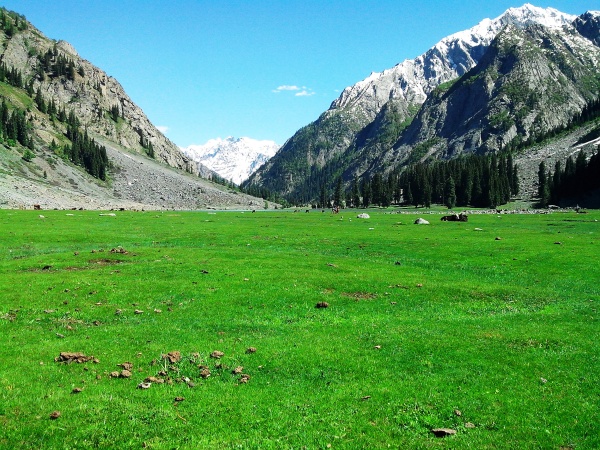 The local cultural presentation and shows in the festival were included by a local civil society organisation,
The local cultural presentation and shows in the festival were included by a local civil society organisation, 


 We started our adventure with the indoor area, which was aptly decorated according to a theme of the approaching Halloween. This indoor part of Lotte World is known as the largest indoor amusement / theme park in the world. Apart from being huge, each of its four floors has a new story to tell and new joys to explore.
We started our adventure with the indoor area, which was aptly decorated according to a theme of the approaching Halloween. This indoor part of Lotte World is known as the largest indoor amusement / theme park in the world. Apart from being huge, each of its four floors has a new story to tell and new joys to explore.
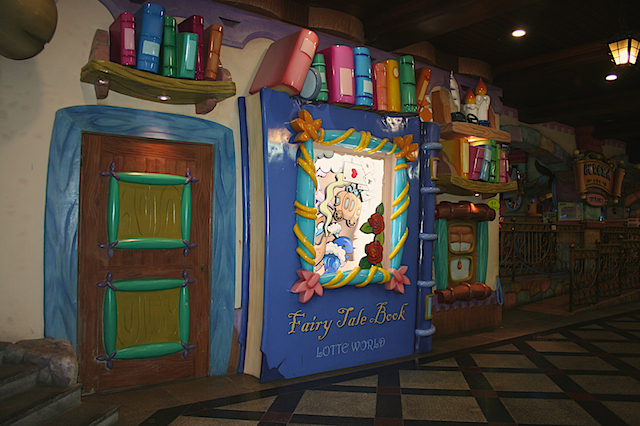 As we were walking through the “Mini Europe” section on the ground floor, catchy music beats caught our attention and we walked in the direction of the music; this led us straight into the centre of the indoor arena. Lucky for us, the Halloween day parade had just started. I could see all the characters coming up, one after the other, dancing to the peppy theme song. There were joyous faces and dancing feet all around. It was truly magical!
As we were walking through the “Mini Europe” section on the ground floor, catchy music beats caught our attention and we walked in the direction of the music; this led us straight into the centre of the indoor arena. Lucky for us, the Halloween day parade had just started. I could see all the characters coming up, one after the other, dancing to the peppy theme song. There were joyous faces and dancing feet all around. It was truly magical!

 After the parade, we continued with our indoor tour. Mini Europe, tomb of horror, the
After the parade, we continued with our indoor tour. Mini Europe, tomb of horror, the 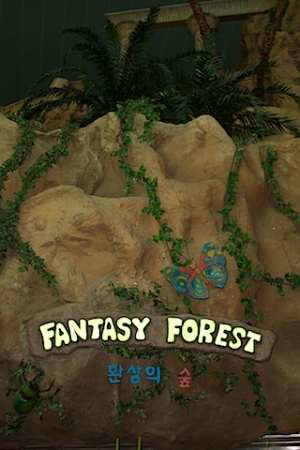
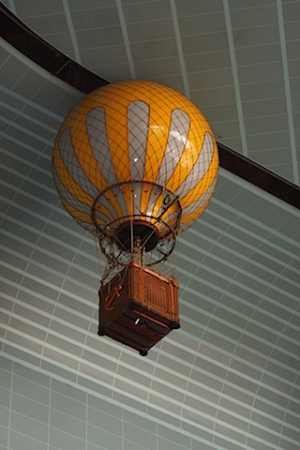 Though we explored all the areas, we skipped most of the rides because of my motion sickness.
However, I did take the Euro Rail tour. It is a mini rail on the second floor, which gives you a circular ride of the indoor area. What you see from there is an astounding view of the whole indoor section along with the ice skating rink in the basement. It just couldn’t get better than this!
Though we explored all the areas, we skipped most of the rides because of my motion sickness.
However, I did take the Euro Rail tour. It is a mini rail on the second floor, which gives you a circular ride of the indoor area. What you see from there is an astounding view of the whole indoor section along with the ice skating rink in the basement. It just couldn’t get better than this!
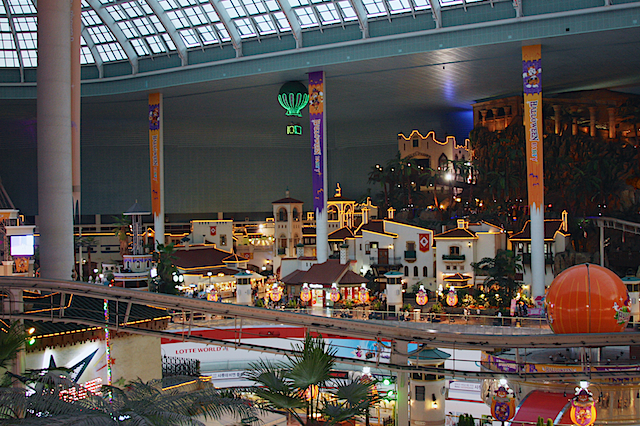 After the indoor area, we left for the outdoor area, to make the most of daylight. The moment I entered this place, appropriately named Magic Island, I was spellbound. There stood the Magic Castle, more or less a replica of Disney’s famous Magic Kingdom. It was a sight to witness.
After the indoor area, we left for the outdoor area, to make the most of daylight. The moment I entered this place, appropriately named Magic Island, I was spellbound. There stood the Magic Castle, more or less a replica of Disney’s famous Magic Kingdom. It was a sight to witness.
 We kept roaming around the castle – in and out - taking pictures. After a while, we finally moved forward. The rides in Magic Island were extremely scary and I just didn’t have the guts to try them. So we skipped them and experienced the lighter parts, such as Snow White’s castle and Geneva cruise lines.
Geneva cruise line is a mini ferry ride that took us on a tour of the lake that surrounds Magic Island. This lake tour not only showed us the milestones of Magic Island, but also allowed us to see parts that we may not have seen otherwise.
We kept roaming around the castle – in and out - taking pictures. After a while, we finally moved forward. The rides in Magic Island were extremely scary and I just didn’t have the guts to try them. So we skipped them and experienced the lighter parts, such as Snow White’s castle and Geneva cruise lines.
Geneva cruise line is a mini ferry ride that took us on a tour of the lake that surrounds Magic Island. This lake tour not only showed us the milestones of Magic Island, but also allowed us to see parts that we may not have seen otherwise.
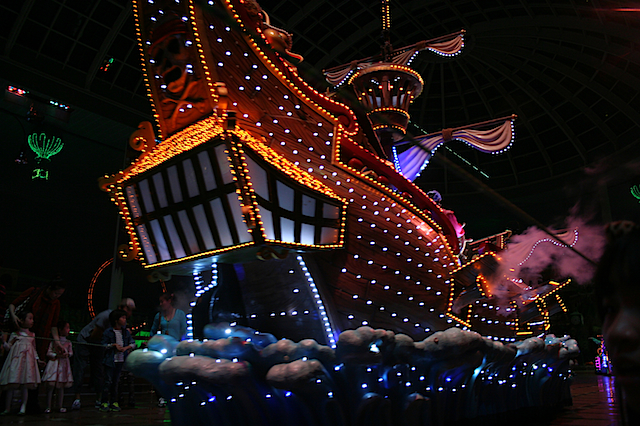 With a promise to return back to witness the island when the lights turned on at night, we went inside to complete the indoor tour. The upper-most floor is the place that distinguishes Lotte from Disney world. It is dedicated to the Korean Folk Museum.
With a promise to return back to witness the island when the lights turned on at night, we went inside to complete the indoor tour. The upper-most floor is the place that distinguishes Lotte from Disney world. It is dedicated to the Korean Folk Museum.
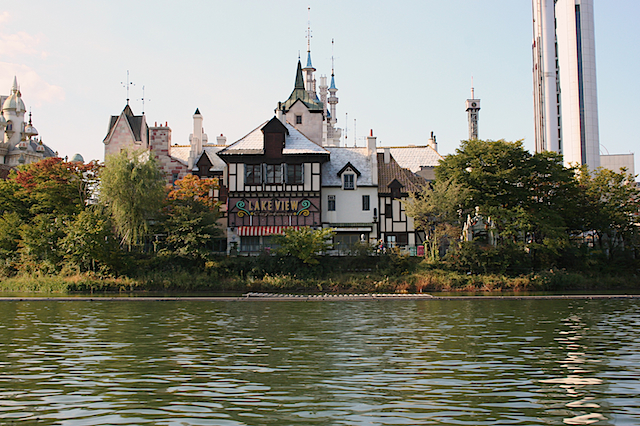 This museum takes you for a journey through South Korea’s stone ages to the revolutionary and literary days, all the way down to the present. It’s huge and absolutely magnificent. Also, over there I witnessed a traditional Korean
This museum takes you for a journey through South Korea’s stone ages to the revolutionary and literary days, all the way down to the present. It’s huge and absolutely magnificent. Also, over there I witnessed a traditional Korean 

 Photo: Pakistan Adventure Tours and Expeditions Facebook page.[/caption]
It requires very high levels of strength, agility, stamina, flexibility and last but not the least, fine motor skills. There are many dare devils out there that are hell bent on not only facing all the challenges of the sport but also setting new records.
Recently,
Photo: Pakistan Adventure Tours and Expeditions Facebook page.[/caption]
It requires very high levels of strength, agility, stamina, flexibility and last but not the least, fine motor skills. There are many dare devils out there that are hell bent on not only facing all the challenges of the sport but also setting new records.
Recently,  Photo: Pakistan Adventure Tours and Expeditions Facebook page.[/caption]
The
Photo: Pakistan Adventure Tours and Expeditions Facebook page.[/caption]
The  Photo: Pakistan Adventure Tours and Expeditions Facebook page.[/caption]
This hefty descend was accomplished in a mere 15 minutes!
On the very same day, both the brothers attempted Qol Sar (6,000 meters) too. In their initial plan they had planned to climb only three peaks (Quz Sar, Manglik Sar and one unnamed peak ), but during the expedition they found that the advance base camps of Qol Sar and Quz Sar were situated quite close to each other and so they decided, on the spot, to attempt Qol Sar too.
[caption id="" align="alignnone" width="337"]
Photo: Pakistan Adventure Tours and Expeditions Facebook page.[/caption]
This hefty descend was accomplished in a mere 15 minutes!
On the very same day, both the brothers attempted Qol Sar (6,000 meters) too. In their initial plan they had planned to climb only three peaks (Quz Sar, Manglik Sar and one unnamed peak ), but during the expedition they found that the advance base camps of Qol Sar and Quz Sar were situated quite close to each other and so they decided, on the spot, to attempt Qol Sar too.
[caption id="" align="alignnone" width="337"] Photo: Pakistan Adventure Tours and Expeditions Facebook page.[/caption]
On July 12, 2013, they set their goals to summit Manglik Sar (6,050 meters). The Manglik Sar summit was covered in six hours and the descent took just 17 minutes via skiing!
[caption id="" align="alignnone" width="600"]
Photo: Pakistan Adventure Tours and Expeditions Facebook page.[/caption]
On July 12, 2013, they set their goals to summit Manglik Sar (6,050 meters). The Manglik Sar summit was covered in six hours and the descent took just 17 minutes via skiing!
[caption id="" align="alignnone" width="600"] Photo: Pakistan Adventure Tours and Expeditions Facebook page.[/caption]
After two days, on July 15, the remaining part of the expedition started. The challenge was to summit an unclimbed peak (6,000 meters). This peak was conquered in three hours and its descent was finished in only 10 minutes of skiing downhill to the advance base camp.
[caption id="" align="alignnone" width="600"]
Photo: Pakistan Adventure Tours and Expeditions Facebook page.[/caption]
After two days, on July 15, the remaining part of the expedition started. The challenge was to summit an unclimbed peak (6,000 meters). This peak was conquered in three hours and its descent was finished in only 10 minutes of skiing downhill to the advance base camp.
[caption id="" align="alignnone" width="600"] Photo: Pakistan Adventure Tours and Expeditions Facebook page.[/caption]
After setting this amazing record, Niamat and Mansoor have set their eyes on many other record breaking events. They are also very keen about promoting Alpine Skiing as a sport.
Alpine Skiing is popular wherever there is a combo of mountain slopes, snow and sufficient tourist infrastructure. In this regard, they want
Photo: Pakistan Adventure Tours and Expeditions Facebook page.[/caption]
After setting this amazing record, Niamat and Mansoor have set their eyes on many other record breaking events. They are also very keen about promoting Alpine Skiing as a sport.
Alpine Skiing is popular wherever there is a combo of mountain slopes, snow and sufficient tourist infrastructure. In this regard, they want  Photo: Pakistan Adventure Tours and Expeditions Facebook page.[/caption]
I congratulate both our brave skiers and pray that their dreams of promoting Alpine Skiing come true! Wishing them all the very best for such future endeavours.
May they earn
Photo: Pakistan Adventure Tours and Expeditions Facebook page.[/caption]
I congratulate both our brave skiers and pray that their dreams of promoting Alpine Skiing come true! Wishing them all the very best for such future endeavours.
May they earn 
 Moderate weather, fresh air and stunning views - a winning combination. Photo: Murtaza Mahmud[/caption]
Moderate weather, fresh air and stunning views - a winning combination. Photo: Murtaza Mahmud[/caption]
 While trekking to Jaz Banda, one has to pass through dense forests. Deforestation rate is not so high in this part of valley, so trekking becomes a real experience. Photo: Murtaza Mahmud[/caption]
It takes another five hours of trekking in dense forests to reach the destination. I would advise tourists to stay a night in Jaz Banda and then trek towards the lake - this will take you close to three hours.
[caption id="" align="alignnone" width="600"]
While trekking to Jaz Banda, one has to pass through dense forests. Deforestation rate is not so high in this part of valley, so trekking becomes a real experience. Photo: Murtaza Mahmud[/caption]
It takes another five hours of trekking in dense forests to reach the destination. I would advise tourists to stay a night in Jaz Banda and then trek towards the lake - this will take you close to three hours.
[caption id="" align="alignnone" width="600"] After trekking for almost 3 hours, you reach this place. We continued our journey towards the right side. Photo: Murtaza Mahmud[/caption]
As far as accommodation is concerned, the best option is to set up camp, as my companions and I did. However, for those who are not comfortable with camping, there is one private rest house in Jandrai and one in Jaz Banda. These rest houses are owned and managed by Mr Raja Taj Muhammad. He is a renowned personality of the area and has been promoting tourism and serving visitors for more than 10 years now.
[caption id="" align="alignnone" width="600"]
After trekking for almost 3 hours, you reach this place. We continued our journey towards the right side. Photo: Murtaza Mahmud[/caption]
As far as accommodation is concerned, the best option is to set up camp, as my companions and I did. However, for those who are not comfortable with camping, there is one private rest house in Jandrai and one in Jaz Banda. These rest houses are owned and managed by Mr Raja Taj Muhammad. He is a renowned personality of the area and has been promoting tourism and serving visitors for more than 10 years now.
[caption id="" align="alignnone" width="600"]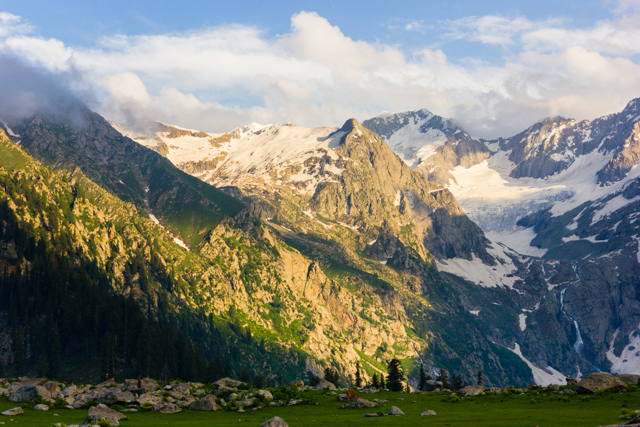 These mountains are the main source of chilled and fresh spring water. Photo: Murtaza Mahmud[/caption]
If I have to describe this place in one sentence, I would say ‘It is just amazing!’
[caption id="" align="alignnone" width="600"]
These mountains are the main source of chilled and fresh spring water. Photo: Murtaza Mahmud[/caption]
If I have to describe this place in one sentence, I would say ‘It is just amazing!’
[caption id="" align="alignnone" width="600"] Katoora Lake waterfall. Photo: Murtaza Mahmud[/caption]
The serenity in the atmosphere puts pains and troubles out of your mind and puts you in a state of peace from where there is no return. One simply cannot forget the time spent there. We spent a night in Jaz Banda, trekking back the next day to continue our adventure through Kumrat Valley.
Personally, I wish to just live here; streams of fresh, chilled water emanating from the lake, high snowy mountains, meadows spread over large expanses, the fresh and pure air – there are so many reasons why this place is absolutely beautiful. Here, you will find yourself closer to nature.
For those who travel alone, this spot offers pleasant company – here, the clouds won’t leave you at any point. As for the lake itself, it takes your breath away for a moment, and then it recharges your mind with its freshness and glory. Just writing about it has me wishing I could go back!
[caption id="" align="alignnone" width="600"]
Katoora Lake waterfall. Photo: Murtaza Mahmud[/caption]
The serenity in the atmosphere puts pains and troubles out of your mind and puts you in a state of peace from where there is no return. One simply cannot forget the time spent there. We spent a night in Jaz Banda, trekking back the next day to continue our adventure through Kumrat Valley.
Personally, I wish to just live here; streams of fresh, chilled water emanating from the lake, high snowy mountains, meadows spread over large expanses, the fresh and pure air – there are so many reasons why this place is absolutely beautiful. Here, you will find yourself closer to nature.
For those who travel alone, this spot offers pleasant company – here, the clouds won’t leave you at any point. As for the lake itself, it takes your breath away for a moment, and then it recharges your mind with its freshness and glory. Just writing about it has me wishing I could go back!
[caption id="" align="alignnone" width="600"] Situated at an altitude of 11,500 ft approximately, it seems like the colour of this lake changes with the weather conditions. Photo: Murtaza Mahmud[/caption]
Of course, we cannot possibly overlook the terrific hospitality shown by the local community of the area. People here are simple, kind and hospitable. Mr Raja Taj Muhammad, the owner of the rest houses mentioned above, is a prime example. We were so impressed by his hospitality that we recorded an interview with him, requesting him to brief us about this place and shed light on the area’s security situation.
http://www.dailymotion.com/video/x11tcpt#.UezTSNKbdnM
[caption id="" align="alignnone" width="600"]
Situated at an altitude of 11,500 ft approximately, it seems like the colour of this lake changes with the weather conditions. Photo: Murtaza Mahmud[/caption]
Of course, we cannot possibly overlook the terrific hospitality shown by the local community of the area. People here are simple, kind and hospitable. Mr Raja Taj Muhammad, the owner of the rest houses mentioned above, is a prime example. We were so impressed by his hospitality that we recorded an interview with him, requesting him to brief us about this place and shed light on the area’s security situation.
http://www.dailymotion.com/video/x11tcpt#.UezTSNKbdnM
[caption id="" align="alignnone" width="600"] Our group and some locals, with Chimrain Cottage in the background. Photo: Murtaza Mahmud[/caption]
During our trek, we met many people who offered us a cup of tea, extending a hand of friendship in their own hospitable way. These people are pursuing a very simple life and eat plain yet healthy food. In pure economical terms, their cost of living is very low. One can guess their general political views via flags and banners of various political parties. These people are self sufficient and this is evident from small irrigation channels and small-scale electricity generation facilities.
I personally feel that a better infrastructure would bring more prosperity to the area and make life easier for these people. They have great respect for their customs and traditions. As a general rule, it becomes the responsibility of travellers to get familiar with and show respect for these local community manners.
[caption id="" align="alignnone" width="300"]
Our group and some locals, with Chimrain Cottage in the background. Photo: Murtaza Mahmud[/caption]
During our trek, we met many people who offered us a cup of tea, extending a hand of friendship in their own hospitable way. These people are pursuing a very simple life and eat plain yet healthy food. In pure economical terms, their cost of living is very low. One can guess their general political views via flags and banners of various political parties. These people are self sufficient and this is evident from small irrigation channels and small-scale electricity generation facilities.
I personally feel that a better infrastructure would bring more prosperity to the area and make life easier for these people. They have great respect for their customs and traditions. As a general rule, it becomes the responsibility of travellers to get familiar with and show respect for these local community manners.
[caption id="" align="alignnone" width="300"]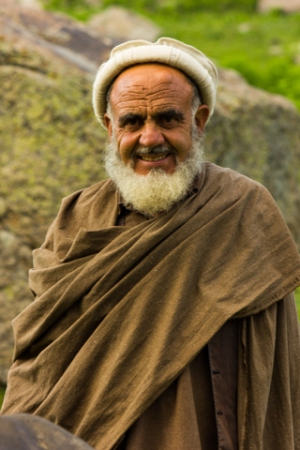 This man requested us to take his picture with his buffalo. I cannot forget his gestures of joy when he saw his photos. Photo: Murtaza Mahmud[/caption]
A special plea to my photographer community - pack your bags and visit this place as soon as you can. It is a brilliant opportunity for your work and can indeed bring you fame through the eye of your gear. As for general adventure-fans, trekkers and travellers, Katoora Lake is an ideal spot for you to explore for your next vacation.
http://www.dailymotion.com/video/x11wskt_katoora-lake_travel
Follow Murtaza on Twitter
This man requested us to take his picture with his buffalo. I cannot forget his gestures of joy when he saw his photos. Photo: Murtaza Mahmud[/caption]
A special plea to my photographer community - pack your bags and visit this place as soon as you can. It is a brilliant opportunity for your work and can indeed bring you fame through the eye of your gear. As for general adventure-fans, trekkers and travellers, Katoora Lake is an ideal spot for you to explore for your next vacation.
http://www.dailymotion.com/video/x11wskt_katoora-lake_travel
Follow Murtaza on Twitter 
 A distant view of the hills near Rampur and my mother walking down the stairs. Photo: Hiba Naeem[/caption]
Thus became the annual, seasonal ritual of escaping to India and it was such an important part of our lives. It was, perhaps, even the most awaited season of the year. We would relish every moment of it, from the rowdy, heart warming
A distant view of the hills near Rampur and my mother walking down the stairs. Photo: Hiba Naeem[/caption]
Thus became the annual, seasonal ritual of escaping to India and it was such an important part of our lives. It was, perhaps, even the most awaited season of the year. We would relish every moment of it, from the rowdy, heart warming  My uncle's wedding in 2001 in India. Photo: Hiba Naeem[/caption]
[caption id="" align="alignnone" width="540"]
My uncle's wedding in 2001 in India. Photo: Hiba Naeem[/caption]
[caption id="" align="alignnone" width="540"] My Khala's wedding in Rampur, India. Photo: Hiba Naeem[/caption]
In retrospect, we fondly remember our visits to India with watery eyes and heavy hearts. We remember boasting about our vacation to the motherland to our friends and family in Pakistan - as if our sun kissed faces, 'narial ki batya' (dry coconuts), chunri k dupattay were not souvenirs enough of our obviously great trip.
Though we are Pakistani, we felt as Indian as our parents and leaving India was as hard for us as it was for them - each time. Bidding adieu while promising to return, our hearts never failed to twitch while we silently confessed with a proud glow on our faces,
My Khala's wedding in Rampur, India. Photo: Hiba Naeem[/caption]
In retrospect, we fondly remember our visits to India with watery eyes and heavy hearts. We remember boasting about our vacation to the motherland to our friends and family in Pakistan - as if our sun kissed faces, 'narial ki batya' (dry coconuts), chunri k dupattay were not souvenirs enough of our obviously great trip.
Though we are Pakistani, we felt as Indian as our parents and leaving India was as hard for us as it was for them - each time. Bidding adieu while promising to return, our hearts never failed to twitch while we silently confessed with a proud glow on our faces,

 Rooftops near North Jerusalem. Photo: Abdullah Saad[/caption]
I am originally a Palestinian from Jerusalem, and like many Palestinians, I suffer (or perhaps benefit) from a severe case of Wanderlust.
[caption id="" align="alignnone" width="600"]
Rooftops near North Jerusalem. Photo: Abdullah Saad[/caption]
I am originally a Palestinian from Jerusalem, and like many Palestinians, I suffer (or perhaps benefit) from a severe case of Wanderlust.
[caption id="" align="alignnone" width="600"] Dome of the Rock. Photo: Abdullah Saad[/caption]
This means that we have to remain on the move because, as a nation that is mostly made up of refugees, hardly any countries present themselves as warm hosts.
[caption id="" align="alignnone" width="600"]
Dome of the Rock. Photo: Abdullah Saad[/caption]
This means that we have to remain on the move because, as a nation that is mostly made up of refugees, hardly any countries present themselves as warm hosts.
[caption id="" align="alignnone" width="600"] People gathering around Masjid Al Aqsa on Eid. Photo: Abdullah Saad[/caption]
It humbled me that during my time in Pakistan, I felt very welcome no matter where I went. Little experiences I’ve had here and there led me to think about the world in a more positive way, but personally experiencing a human miracle, however, can permanently instil a positive outlook in a person.
[caption id="" align="alignnone" width="600"]
People gathering around Masjid Al Aqsa on Eid. Photo: Abdullah Saad[/caption]
It humbled me that during my time in Pakistan, I felt very welcome no matter where I went. Little experiences I’ve had here and there led me to think about the world in a more positive way, but personally experiencing a human miracle, however, can permanently instil a positive outlook in a person.
[caption id="" align="alignnone" width="600"] The Apartheid Wall. Photo: Abdullah Saad[/caption]
My
The Apartheid Wall. Photo: Abdullah Saad[/caption]
My  Chitral’s scenery. Photo: Abdullah Saad[/caption]
When I told my family and friends that I was headed to Pakistan, I was told that if I had to go, I should avoid the “dangerous North” of the country. There is a long history of Arabs having gone to the North of Pakistan and having their lives turned around. My namesake, Abdullah Azzam, was one such Arab who originally arrived in Pakistan as a teacher, but upon his death was known as “the father of global Jihad”.
[caption id="" align="alignnone" width="600"]
Chitral’s scenery. Photo: Abdullah Saad[/caption]
When I told my family and friends that I was headed to Pakistan, I was told that if I had to go, I should avoid the “dangerous North” of the country. There is a long history of Arabs having gone to the North of Pakistan and having their lives turned around. My namesake, Abdullah Azzam, was one such Arab who originally arrived in Pakistan as a teacher, but upon his death was known as “the father of global Jihad”.
[caption id="" align="alignnone" width="600"] A beautiful town in Chitral. Photo: Abdullah Saad[/caption]
It did not help that he was also a Palestinian. This is not to mention, however, the infamous Osama Bin Laden, who hid in the north of the country for years; another Arab experience that shapes the view that my compatriots have of Pakistan and its northern regions.
Despite the fact that I left Chitral with damaged ankle ligaments, my life changed for the better over there. I went there as a typically cynical student of political science and left having experienced a marvel that changed the way I viewed human nature.
My arrival in Chitral was different from my arrival in Lahore roughly six weeks earlier. Contrary to my visit to the colourful city of Lahore, I had no knowledge of Chitral and its culture, and I went on my own rather than accompanied by a Pakistani. At the airport, I was received by Amaar, my Chitrali host. Even though I did not know what he looked like or who he was, it was not very difficult for us to locate each other. To my surprise, he greeted me with a huge, welcoming hug, as if we were long-lost friends rather than new acquaintances!
[caption id="" align="alignnone" width="600"]
A beautiful town in Chitral. Photo: Abdullah Saad[/caption]
It did not help that he was also a Palestinian. This is not to mention, however, the infamous Osama Bin Laden, who hid in the north of the country for years; another Arab experience that shapes the view that my compatriots have of Pakistan and its northern regions.
Despite the fact that I left Chitral with damaged ankle ligaments, my life changed for the better over there. I went there as a typically cynical student of political science and left having experienced a marvel that changed the way I viewed human nature.
My arrival in Chitral was different from my arrival in Lahore roughly six weeks earlier. Contrary to my visit to the colourful city of Lahore, I had no knowledge of Chitral and its culture, and I went on my own rather than accompanied by a Pakistani. At the airport, I was received by Amaar, my Chitrali host. Even though I did not know what he looked like or who he was, it was not very difficult for us to locate each other. To my surprise, he greeted me with a huge, welcoming hug, as if we were long-lost friends rather than new acquaintances!
[caption id="" align="alignnone" width="600"] Chitral airport. Photo: Abdullah Saad[/caption]
The first thing I did on my arrival, as all foreigners are required to do, was register with the police in order to be assigned a police escort. I was accompanied by the police escort over the next couple of days, as I explored the area around Amaar’s village – the quaint and quiet
Chitral airport. Photo: Abdullah Saad[/caption]
The first thing I did on my arrival, as all foreigners are required to do, was register with the police in order to be assigned a police escort. I was accompanied by the police escort over the next couple of days, as I explored the area around Amaar’s village – the quaint and quiet  Garam Chashma. Photo: Abdullah Saad[/caption]
I could spend hours writing about the breathtaking scenery surrounding Chitral and the activities that we undertook during my stay; but frankly the highlight of my trip was the response to a heavy storm on the evening before my return to Islamabad.
[caption id="" align="alignnone" width="600"]
Garam Chashma. Photo: Abdullah Saad[/caption]
I could spend hours writing about the breathtaking scenery surrounding Chitral and the activities that we undertook during my stay; but frankly the highlight of my trip was the response to a heavy storm on the evening before my return to Islamabad.
[caption id="" align="alignnone" width="600"] Storm clouds. Photo: Abdullah Saad[/caption]
During the day we had hired a car and driven to Bomboret Village, a part of the Kalash Valley, which is possibly the most unique area in Pakistan due to the Kalash people’s preservation of their own distinctive culture.
[caption id="" align="alignnone" width="600"]
Storm clouds. Photo: Abdullah Saad[/caption]
During the day we had hired a car and driven to Bomboret Village, a part of the Kalash Valley, which is possibly the most unique area in Pakistan due to the Kalash people’s preservation of their own distinctive culture.
[caption id="" align="alignnone" width="600"] Kalash Museum. Photo: Abdullah Saad[/caption]
[caption id="" align="alignnone" width="600"]
Kalash Museum. Photo: Abdullah Saad[/caption]
[caption id="" align="alignnone" width="600"] Kalash women in traditional attire. Photo: Abdullah Saad[/caption]
In the evening, just as we were getting ready for our return to Chitral Town, heavy clouds began to gather on the horizon. In just an hour, we found ourselves in the midst of the worst storm I have ever seen, stuck in sloppy mud somewhere near Bomboret. The sheer force with which mud was hitting the side of our car made us realise that there was a good chance of our car falling into the river running parallel to the track.
[caption id="" align="alignnone" width="600"]
Kalash women in traditional attire. Photo: Abdullah Saad[/caption]
In the evening, just as we were getting ready for our return to Chitral Town, heavy clouds began to gather on the horizon. In just an hour, we found ourselves in the midst of the worst storm I have ever seen, stuck in sloppy mud somewhere near Bomboret. The sheer force with which mud was hitting the side of our car made us realise that there was a good chance of our car falling into the river running parallel to the track.
[caption id="" align="alignnone" width="600"] A Chitral town. Photo: Abdullah Saad[/caption]
Hence, we decided that the only thing to do was to abandon the car and remain on the move until we found some shelter. We left the car and started walking together, but due to the gathering darkness and heavy rain getting into our eyes, many of us got separated. After some time, I realised that I was alone and to make matters worse, I did not have my glasses or any light to guide me; not that I would have known which direction to go in, anyway.
Eventually, after sloshing through mud and trying to stay on my feet, I came across two men, who thankfully turned out to be my police escorts. They literally held me by my arms and took me to a mosque, where I was greeted by an old Imam who later took me to his house. At the house, I was re-united with Amaar and the others in our group.
[caption id="" align="alignnone" width="600"]
A Chitral town. Photo: Abdullah Saad[/caption]
Hence, we decided that the only thing to do was to abandon the car and remain on the move until we found some shelter. We left the car and started walking together, but due to the gathering darkness and heavy rain getting into our eyes, many of us got separated. After some time, I realised that I was alone and to make matters worse, I did not have my glasses or any light to guide me; not that I would have known which direction to go in, anyway.
Eventually, after sloshing through mud and trying to stay on my feet, I came across two men, who thankfully turned out to be my police escorts. They literally held me by my arms and took me to a mosque, where I was greeted by an old Imam who later took me to his house. At the house, I was re-united with Amaar and the others in our group.
[caption id="" align="alignnone" width="600"] The group of men who saved me. Photo: Abdullah Saad[/caption]
What followed was even more exceptional, with people coming to the Imam’s house with essentials such as fresh clothes, water and in my case, footwear. I was amazed by the fact that in spite of the terrible weather, the life-threatening travel conditions for those walking on foot, and the difficult terrain, people still came out to our aid.
[caption id="" align="alignnone" width="600"]
The group of men who saved me. Photo: Abdullah Saad[/caption]
What followed was even more exceptional, with people coming to the Imam’s house with essentials such as fresh clothes, water and in my case, footwear. I was amazed by the fact that in spite of the terrible weather, the life-threatening travel conditions for those walking on foot, and the difficult terrain, people still came out to our aid.
[caption id="" align="alignnone" width="600"] A view from the hotel. Photo: Abdullah Saad[/caption]
It was truly the most heart-warming and humbling experience of my life. Despite the language barrier, my injuries and lack of vision, I was simply revitalised by the sheer humanity and generosity of the people who helped me during this experience. It may seem ironic, not to mention downright perverse to attempt promoting tourism in Pakistan by writing about a natural disaster; but the level of hospitality that I experienced far surpassed any hospitality that I have experienced anywhere else in the world.
[caption id="" align="alignnone" width="600"]
A view from the hotel. Photo: Abdullah Saad[/caption]
It was truly the most heart-warming and humbling experience of my life. Despite the language barrier, my injuries and lack of vision, I was simply revitalised by the sheer humanity and generosity of the people who helped me during this experience. It may seem ironic, not to mention downright perverse to attempt promoting tourism in Pakistan by writing about a natural disaster; but the level of hospitality that I experienced far surpassed any hospitality that I have experienced anywhere else in the world.
[caption id="" align="alignnone" width="600"] Chitrali children. Photo: Abdullah Saad[/caption]
It is incidents like these that make Pakistan what it is. For every disaster or
Chitrali children. Photo: Abdullah Saad[/caption]
It is incidents like these that make Pakistan what it is. For every disaster or  One of Methar's castle. Photo: Abdullah Saad[/caption]
To some extent this may partly be due to the fact that acts like these are considered normal by the helpful people of Pakistan and hence, nobody considers them newsworthy. However, I feel responsible as a writer who has personally experienced such amazing levels of concern and hospitality, to ensure that the story is told regardless.
A tiny part of me hopes that it helps restore some much-needed
One of Methar's castle. Photo: Abdullah Saad[/caption]
To some extent this may partly be due to the fact that acts like these are considered normal by the helpful people of Pakistan and hence, nobody considers them newsworthy. However, I feel responsible as a writer who has personally experienced such amazing levels of concern and hospitality, to ensure that the story is told regardless.
A tiny part of me hopes that it helps restore some much-needed 
 Inside the grand Blue Mosque. Photo: Farwa Aamer[/caption]
The region literally encapsulates the best of what the world has seen over the decades.
I was truly awed by the remarkable wonders of nature that exist in the country, particularly the travertines of Pamukale and the colossal
Inside the grand Blue Mosque. Photo: Farwa Aamer[/caption]
The region literally encapsulates the best of what the world has seen over the decades.
I was truly awed by the remarkable wonders of nature that exist in the country, particularly the travertines of Pamukale and the colossal  Turkish tea is a must-have the next time you are in Turkey. Photo: Farwa Aamer[/caption]
Turkish tea is a must-have the next time you are in Turkey. Photo: Farwa Aamer[/caption]
 Looking for ceramics, lamps, clothes and spices? The Grand Bazaar is the place to go! Photo: Farwa Aamer[/caption]
Looking for ceramics, lamps, clothes and spices? The Grand Bazaar is the place to go! Photo: Farwa Aamer[/caption]
 A cruise on the Bosphorus. Photo: Farwa Aamer[/caption]
A cruise on the Bosphorus. Photo: Farwa Aamer[/caption]
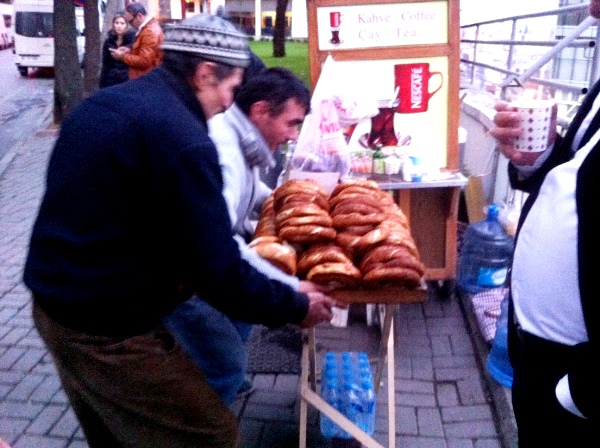 Enjoy some Simet as you get lost in the history of Turkey. Photo: Farwa Aamer[/caption]
Chestnuts are another local favourite snack and are sold roasted and warm.
[caption id="" align="alignnone" width="600"]
Enjoy some Simet as you get lost in the history of Turkey. Photo: Farwa Aamer[/caption]
Chestnuts are another local favourite snack and are sold roasted and warm.
[caption id="" align="alignnone" width="600"]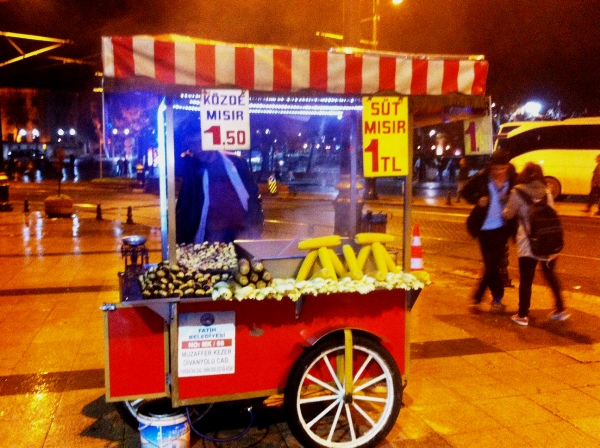 Roasted chestnuts are easily available in Turkey and are wonderful to munch on while you stroll through the cobbled streets. Photo: Farwa Aamer[/caption]
Roasted chestnuts are easily available in Turkey and are wonderful to munch on while you stroll through the cobbled streets. Photo: Farwa Aamer[/caption]
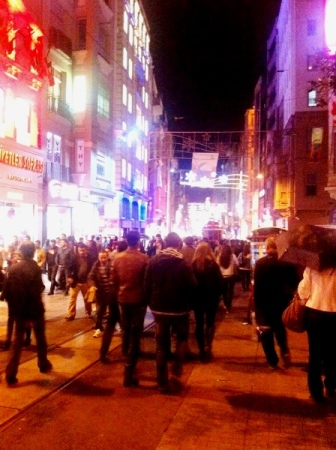 Tourists and shoppers on Istiklal Street. Photo: Farwa Aamer[/caption]
I especially love the fancy little trams that run between the streets.
[caption id="" align="alignnone" width="336"]
Tourists and shoppers on Istiklal Street. Photo: Farwa Aamer[/caption]
I especially love the fancy little trams that run between the streets.
[caption id="" align="alignnone" width="336"] A tram weaving its way through Istiklal Street. Photo: Farwa Aamer[/caption]
A tram weaving its way through Istiklal Street. Photo: Farwa Aamer[/caption]

 Photo: Dilaira Mondegarian[/caption]
Let alone a united Pakistan, can you, on your own, even imagine women participating in a dance parade dressed in a sari or
Photo: Dilaira Mondegarian[/caption]
Let alone a united Pakistan, can you, on your own, even imagine women participating in a dance parade dressed in a sari or  Photo: Dilaira Mondegarian[/caption]
[caption id="" align="alignnone" width="337"]
Photo: Dilaira Mondegarian[/caption]
[caption id="" align="alignnone" width="337"] Photo: Dilaira Mondegarian[/caption]
For the sake of many traditionalists who might argue that beneath Malaysia’s glittering ‘facade’ is a growing wave of disconnect from its Islamic roots and other Islamic nations, the country openly endorses itself as
Photo: Dilaira Mondegarian[/caption]
For the sake of many traditionalists who might argue that beneath Malaysia’s glittering ‘facade’ is a growing wave of disconnect from its Islamic roots and other Islamic nations, the country openly endorses itself as  Photo: Dilaira Mondegarian[/caption]
In fact, many non-Muslims who visit the country return home with spiritual enlightenment. At the Putra mosque, in Putrajaya, the tour guide claimed that some revisit Malaysia to convert to Islam, and this year, for the first time, a marriage ceremony will be performed at the mosque for one of the converts.
[caption id="" align="alignnone" width="584"]
Photo: Dilaira Mondegarian[/caption]
In fact, many non-Muslims who visit the country return home with spiritual enlightenment. At the Putra mosque, in Putrajaya, the tour guide claimed that some revisit Malaysia to convert to Islam, and this year, for the first time, a marriage ceremony will be performed at the mosque for one of the converts.
[caption id="" align="alignnone" width="584"] Photo: Dilaira Mondegarian[/caption]
Pakistan has a lot to learn from Malaysia’s cultural mosaic that has not only catapulted tourism in the country but also cemented its status worldwide as a Muslim-majority nation with a progressive outlook. And while we may still be light years away from mirroring Malaysia’s model for peace and tourism, I guess there is no harm in at least talking about the possibility of it for now.
Photo: Dilaira Mondegarian[/caption]
Pakistan has a lot to learn from Malaysia’s cultural mosaic that has not only catapulted tourism in the country but also cemented its status worldwide as a Muslim-majority nation with a progressive outlook. And while we may still be light years away from mirroring Malaysia’s model for peace and tourism, I guess there is no harm in at least talking about the possibility of it for now.
 Maula ki basti (70kms from Naran). Photo: Hasan Ali Sharif[/caption]
[caption id="" align="alignnone" width="600"]
Maula ki basti (70kms from Naran). Photo: Hasan Ali Sharif[/caption]
[caption id="" align="alignnone" width="600"] Maula ki basti (70kms from Naran). Photo: Hasan Ali Sharif[/caption]
[caption id="" align="alignnone" width="600"]
Maula ki basti (70kms from Naran). Photo: Hasan Ali Sharif[/caption]
[caption id="" align="alignnone" width="600"] Maula ki basti (70kms from Naran). Photo: Hasan Ali Sharif[/caption]
[caption id="" align="alignnone" width="600"]
Maula ki basti (70kms from Naran). Photo: Hasan Ali Sharif[/caption]
[caption id="" align="alignnone" width="600"] Maula ki basti (70kms from Naran). Photo: Hasan Ali Sharif[/caption]
[caption id="" align="alignnone" width="600"]
Maula ki basti (70kms from Naran). Photo: Hasan Ali Sharif[/caption]
[caption id="" align="alignnone" width="600"] Basil. Photo Hasan Ali Sharif[/caption]
[caption id="" align="alignnone" width="473"]
Basil. Photo Hasan Ali Sharif[/caption]
[caption id="" align="alignnone" width="473"] Diran and Rakaposhi. Photo: Hasan Ali Sharif[/caption]
[caption id="" align="alignnone" width="600"]
Diran and Rakaposhi. Photo: Hasan Ali Sharif[/caption]
[caption id="" align="alignnone" width="600"] Meer Peak at Hoper Valley. Photo: Hasan Ali Sharif[/caption]
[caption id="" align="alignnone" width="600"]
Meer Peak at Hoper Valley. Photo: Hasan Ali Sharif[/caption]
[caption id="" align="alignnone" width="600"] Meer Glacier at Minapin. Photo: Hasan Ali Sharif[/caption]
[caption id="" align="alignnone" width="600"]
Meer Glacier at Minapin. Photo: Hasan Ali Sharif[/caption]
[caption id="" align="alignnone" width="600"] Maula Ki Basti Base Camp. Photo: Hasan Ali Sharif[/caption]
[caption id="" align="alignnone" width="600"]
Maula Ki Basti Base Camp. Photo: Hasan Ali Sharif[/caption]
[caption id="" align="alignnone" width="600"] Maula Ki Basti Base Camp. Photo: Hasan Ali Sharif[/caption]
[caption id="" align="alignnone" width="600"]
Maula Ki Basti Base Camp. Photo: Hasan Ali Sharif[/caption]
[caption id="" align="alignnone" width="600"] Basil. Photo: Hasan Ali Sharif[/caption]
[caption id="" align="alignnone" width="600"]
Basil. Photo: Hasan Ali Sharif[/caption]
[caption id="" align="alignnone" width="600"] Basil River. Photo: Hasan Ali Sharif[/caption]
[caption id="" align="alignnone" width="253"]
Basil River. Photo: Hasan Ali Sharif[/caption]
[caption id="" align="alignnone" width="253"] Maula Ki Basti. Photo: Hasan Ali Sharif[/caption]
[caption id="" align="alignnone" width="600"]
Maula Ki Basti. Photo: Hasan Ali Sharif[/caption]
[caption id="" align="alignnone" width="600"] Maula Ki Basti Base Camp. Photo: Hasan Ali Sharif[/caption]
[caption id="" align="alignnone" width="600"]
Maula Ki Basti Base Camp. Photo: Hasan Ali Sharif[/caption]
[caption id="" align="alignnone" width="600"] Maula Ki Basti Base Camp. Photo: Hasan Ali Sharif[/caption]
[caption id="" align="alignnone" width="216"]
Maula Ki Basti Base Camp. Photo: Hasan Ali Sharif[/caption]
[caption id="" align="alignnone" width="216"] Maula Ki Basti. Photo: Hasan Ali Sharif[/caption]
[caption id="" align="alignnone" width="443"]
Maula Ki Basti. Photo: Hasan Ali Sharif[/caption]
[caption id="" align="alignnone" width="443"] Maula Ki Basti. Photo: Hasan Ali Sharif[/caption]
[caption id="" align="alignnone" width="600"]
Maula Ki Basti. Photo: Hasan Ali Sharif[/caption]
[caption id="" align="alignnone" width="600"] Maula Ki Basti. Photo: Hasan Ali Sharif[/caption]
[caption id="" align="alignnone" width="600"]
Maula Ki Basti. Photo: Hasan Ali Sharif[/caption]
[caption id="" align="alignnone" width="600"] Basil. Photo: Hasan Ali Sharif[/caption]
[caption id="" align="alignnone" width="483"]
Basil. Photo: Hasan Ali Sharif[/caption]
[caption id="" align="alignnone" width="483"] Maula Ki Basti. Photo: Hasan Ali Sharif[/caption]
People lead the simplest of lives in these vast mountains and valleys. They find happiness in the smallest of matters; whether it rains or not can become a matter of life and death for them. This may sound extreme but that is because the importance they give to things there could mean absolutely nothing to those living in the fast tracks of city life. They perceive life differently.
Age has no limits to the way they live. From a child to an old woman, everyone works for their household and livelihood, albeit to carry lots of wood or herd their cattle. A minor gesture from us
Maula Ki Basti. Photo: Hasan Ali Sharif[/caption]
People lead the simplest of lives in these vast mountains and valleys. They find happiness in the smallest of matters; whether it rains or not can become a matter of life and death for them. This may sound extreme but that is because the importance they give to things there could mean absolutely nothing to those living in the fast tracks of city life. They perceive life differently.
Age has no limits to the way they live. From a child to an old woman, everyone works for their household and livelihood, albeit to carry lots of wood or herd their cattle. A minor gesture from us